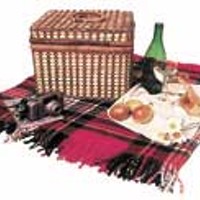The bountiful table is far removed from the food that would have been at the very first Christmas. The meals that most likely were served at that time could be considered the original Mediterranean diet, and many of the foods are still eaten today.
Mainstays of today's Mediterranean diet, tomatoes and peppers didn't make their appearance in that part of the world until after Columbus brought them back from the Americas. Same goes for potatoes. But watermelon, cucumbers, figs and olives were staples of that early diet. Lentils, fava beans, garbanzo beans (chick peas), leeks, onions and garlic were all used. Although citrus fruit probably wasn't cultivated in that area during those times, pomegranates, figs, grapes and dates were, along with almonds, pistachios and other nuts.
Dairy products like cheese and yogurt were available, mostly made from goat's milk. Meat and poultry were expensive, and rarely eaten by peasants, except on feast days. Hunters could supplement their daily fare with wild goat, deer or antelope. Those of modest means augmented their essentially vegetarian diet by fishing. Sardines were abundant in the Mediterranean and tilapia swam in the Sea of Galilee. Insects, like locusts, provided another source of protein.
One half of the caloric intake of much of the ancient Mediterranean region came from bread and grains like wheat, barley, millet or spelt.
Sweets, which are so important to our holiday celebrations, were not that easy to come by. Sugar cane was grown in some parts of the Holy Land, but the process of refining it had not yet been discovered. The juice of figs, dates or grapes was boiled down to make thick, sweet syrup, and wild honey was used as a sweetener and a preservative.
Although spiked eggnog and Cosmopolitans were many centuries off, the juice of grapes was used to make wine long before Jesus performed his miracle at Cana.
In his book What Would Jesus Eat?, Dr. Don Colbert, a physician and nutritionist, says, "The gluttonous spirit is deadly. I've seen so many diseases related to dietary excess, so why not go back to the owner's manual, the Bible, to see what Jesus ate?" The Mediterranean diet has been around for millennia, and its value and wisdom have been confirmed over and over. But somehow a Christmas dinner of locusts and spelt doesn't quite evoke the joy and contentment of a sumptuous feast with all the decadent trimmings. And, after all, Christmas comes but once a year.
Speaking of Cuisine_chew.html
-
At Your Service
Jun 29, 2005 -
It's the Berries
Jun 15, 2005 -

It's Picnic Time
Jun 8, 2005 - More »
Latest in Chew on This
More by Linda Vespa
-
Well, It's Diet Time Again
Nov 27, 2019 -

Urban Explorer's Handbook 2006
Mar 8, 2006 -

American Gluttony
Nov 23, 2005 - More »
Calendar
-

Charlotte Wine & Food Week’s Annual Sake Dinner at Mizu @ Mizu
-

Hands On Cocktail Class Featuring Gin at DTR Southpark @ DTR SouthPark
-

Angeline’s Featuring Sciandri Family Vineyards @ Angeline's
-

Aria Tuscan Grill Featuring Allegrini - Charlotte Wine + Food Week @ Aria Tuscan Grill
-

Charlotte Wine + Food Week Presented by Truist @ Charlotte, NC
-
Authentic New York-style Bagels Come to South End 1
Poppy's expands its empire
-
Dorie Greenspan's Tiramisu Cake
This layered cake is definitely a "pick-me-up" with a little booze and caffeine.
-
Back of the Box: No Boil Classic Lasagne 5
Not having to boil the noodles rocks!







